Land Use/Land Cover Change Detection and NDVI Estimation in Pakistan’s Southern Punjab Province
Abstract
1. Introduction
- (1)
- Create LULC maps for Southern Punjab, Pakistan, which includes 16 districts, for the years 2000, 2007, 2014, and 2021;
- (2)
- Identify LULC changes between 2000 and 2021;
- (3)
- Calculate the normalized difference vegetation index (NDVI) to examine vegetation status.
2. Study Area and Dataset
2.1. Study Area
2.2. Data Collection
3. Adopted Methodology
3.1. Data Pre-Processing
3.2. Data Classification
3.3. Post-Classification Change Detection
3.4. Accuracy Assessment
3.5. Normalized Difference Vegetation Index (NDVI)
4. Study Results
4.1. LULC Change Analysis
4.2. Accuracy Measurement
4.3. NDVI Analysis
5. Discussion
6. Conclusions
Author Contributions
Funding
Institutional Review Board Statement
Informed Consent Statement
Data Availability Statement
Acknowledgments
Conflicts of Interest
References
- Long, H. Theorizing land use transitions: A human geography perspective. Habitat Int. 2022, 128, 102669. [Google Scholar] [CrossRef]
- Roy, P.S.; Ramachandran, R.M.; Paul, O.; Thakur, P.K.; Ravan, S.; Behera, M.D.; Sarangi, C.; Kanawade, V.P. Anthropogenic land use and land cover changes—A review on its environmental consequences and climate change. J. Indian Soc. Remote Sens. 2022, 50, 1615–1640. [Google Scholar] [CrossRef]
- Löbmann, M.T.; Maring, L.; Prokop, G.; Brils, J.; Bender, J.; Bispo, A.; Helming, K. Systems knowledge for sustainable soil and land management. Sci. Total. Environ. 2022, 822, 153389. [Google Scholar] [CrossRef] [PubMed]
- Hammad, H.M.; Abbas, F.; Saeed, S.; Fahad, S.; Cerdà, A.; Farhad, W.; Bernardo, C.C.; Nasim, W.; Mubeen, M.; Bakhat, H.F. Offsetting land degradation through nitrogen and water management during maize cultivation under arid conditions. Land Degrad. Dev. 2018, 29, 1366–1375. [Google Scholar] [CrossRef]
- Sahana, M.; Ahmed, R.; Sajjad, H. Analyzing land surface temperature distribution in response to land use/land cover change using split window algorithm and spectral radiance model in Sundarban Biosphere Reserve, India. Model. Earth Syst. Environ. 2016, 2, 81. [Google Scholar] [CrossRef]
- Naz, A.; Rasheed, H. Modeling the Rice Land Suitability Using GIS and Multi-Criteria Decision Analysis Approach in Sindh, Pakistan. J. Basic Appl. Sci. 2017, 13, 26–33. [Google Scholar] [CrossRef]
- Romaguera, M.; Vaughan, R.; Ettema, J.; Izquierdo-Verdiguier, E.; Hecker, C.; van der Meer, F. Detecting geothermal anomalies and evaluating LST geothermal component by combining thermal remote sensing time series and land surface model data. Remote Sens. Environ. 2018, 204, 534–552. [Google Scholar] [CrossRef]
- Kidane, M.; Tolessa, T.; Bezie, A.; Kessete, N.; Endrias, M. Evaluating the impacts of climate and land use/land cover (LU/LC) dynamics on the hydrological responses of the upper Blue nile in the central Highlands of Ethiopia. Spatial Info. Res. 2019, 27, 151–167. [Google Scholar] [CrossRef]
- Chaudhary, S.; Pandey, A.C. Multiple indices based drought analysis by using long term climatic variables over a part of Koel river basin, India. Spat. Inf. Res. 2019, 28, 273–285. [Google Scholar] [CrossRef]
- Imran, M.A.; Ali, A.; Ashfaq, M.; Hassan, S.; Culas, R.; Ma, C. Impact of Climate Smart Agriculture (CSA) Practices on Cotton Production and Livelihood of Farmers in Punjab, Pakistan. Sustainability 2018, 10, 2101. [Google Scholar] [CrossRef]
- Usman, M.; Liedl, R.; Shahid, M.A.; Abbas, A. Land use/land cover classification and its change detection using multi-temporal MODIS NDVI data. J. Geogr. Sci. 2015, 25, 1479–1506. [Google Scholar] [CrossRef]
- Forkel, M.; Carvalhais, N.; Verbesselt, J.; Mahecha, M.D.; Neigh, C.S.R.; Reichstein, M. Trend Change Detection in NDVI Time Series: Effects of Inter-Annual Variability and Methodology. Remote Sens. 2013, 5, 2113–2144. [Google Scholar] [CrossRef]
- Cheema, M.; Bastiaanssen, W. Land use and land cover classification in the irrigated Indus Basin using growth phenology information from satellite data to support water management analysis. Agric. Water Manag. 2010, 97, 1541–1552. [Google Scholar] [CrossRef]
- Ahmed, J.; Ahmed, M.; Laghari, A.; Lohana, W.; Ali, S.; Fatmi, Z. Public private mix model in enhancing tuberculosis case detection in District Thatta, Sindh, Pakistan. J. Pak. Med. Assoc. 2009, 59, 82. [Google Scholar]
- Kantakumar, L.N.; Neelamsetti, P. Multi-temporal land use classification using hybrid approach. Egypt. J. Rem. Sens. Space Sci. 2015, 18, 289–295. [Google Scholar] [CrossRef]
- Athick, A.M.A.; Shankar, K.; Naqvi, H.R. Data on time series analysis of land surface temperature variation in response to vegetation indices in twelve Wereda of Ethiopia using mono window, split window algorithm and spectral radiance model. Data Brief 2019, 27, 104773. [Google Scholar] [CrossRef]
- Jia, K.; Liang, S.; Wei, X.; Yao, Y.; Su, Y.; Jiang, B.; Wang, X. Land Cover Classification of Landsat Data with Phenological Features Extracted from Time Series MODIS NDVI Data. Remote Sens. 2014, 6, 11518–11532. [Google Scholar] [CrossRef]
- Sateesh, K.; Sandip, G. Land Use and Land Cover Mapping using Digital Classification Technique in Tikamgarh District, Madhya Pradesh, India using Remote Sensing. Int. J. Geomat. Geosci. 2011, 2, 519. Available online: https://www.indianjournals.com/ijor.aspx?target=ijor:ijggs&volume=2&issue=2&article=015 (accessed on 21 December 2022).
- Sheikh, A.B.; Parvez, S.; Ikram, M.; Baber, H. Land Suitability Assessment for Maize Crop in Okara District using GIS Techniques. Int. J. Life Sci. Res. 2017, 5, 37–44. Available online: https://www.researchpublish.com/upload/book/LAND%20SUITABILITY%20ASSESSMENT-4526.pdf (accessed on 23 December 2022).
- Kumar, P.; Husain, A.; Singh, R.B.; Kumar, M. Impact of land cover change on land surface temperature: A case study of Spiti Valley. J. Mt. Sci. 2018, 15, 1658–1670. [Google Scholar] [CrossRef]
- Sabagh, A.E.; Hossain, A.; Islam, M.S.; Iqbal, M.A.; Fahad, S.; Ratnasekera, D.; Llanes, A. Consequences and mitigation strategies of heat stress for sustainability of soybean (Glycine max L. Merr.) production under the changing climate. In Plant Stress Physiology; IntechOpen: London, UK, 2020. [Google Scholar] [CrossRef]
- Khan, I.; Javed, T.; Khan, A.; Lei, H.; Muhammad, I.; Ali, I.; Huo, X. Impact assessment of land use change on surface temperature and agricultural productivity in Peshawar-Pakistan. Environ. Sci. Pollut. Res. 2019, 26, 33076–33085. [Google Scholar] [CrossRef]
- Ali, A.; Khalid, A.; Butt, M.A.; Mehmood, R.; Mahmood, S.A.; Sami, J.; Ali, F. Towards a remote sensing and GIS-based technique to study population and urban growth: A case study of multan. Adv. Rem. Sens. 2018, 7, 245. [Google Scholar] [CrossRef]
- Gilani, H.; Shrestha, H.L.; Murthy, M.; Phuntso, P.; Pradhan, S.; Bajracharya, B.; Shrestha, B. Decadal land cover change dynamics in Bhutan. J. Environ. Manag. 2015, 148, 91–100. [Google Scholar] [CrossRef]
- Sultana, S.R.; Ali, A.; Ahmad, A.; Mubeen, M.; Zia-Ul-Haq, M.; Ahmad, S.; Ercisli, S.; Jaafar, H.Z.E. Normalized Difference Vegetation Index as a Tool for Wheat Yield Estimation: A Case Study from Faisalabad, Pakistan. Sci. World J. 2014, 2014, 1–8. [Google Scholar] [CrossRef] [PubMed]
- Tan, K.C.; Lim, H.S.; MatJafri, M.Z.; Abdullah, K. Landsat data to evaluate urban expansion and determine land use/land cover changes in Penang Island, Malaysia. Environ. Earth Sci. 2010, 60, 1509–1521. [Google Scholar] [CrossRef]
- Safder, Q. Assessment of Urbanization and Urban Sprawl Analysis through Remote Sensing and GIS: A Case Study of Faisalabad, Punjab, Pakistan. Int. J. Acad. Res. Bus. Soc. Sci. 2019, 9. [Google Scholar] [CrossRef] [PubMed]
- Athick, A.M.A.; Shankar, K. Data on land use and land cover changes in Adama Wereda, Ethiopia, on ETM+, TM and OLI- TIRS landsat sensor using PCC and CDM techniques. Data Brief 2019, 24, 103880. [Google Scholar] [CrossRef] [PubMed]
- Verburg, P.H.; van Eck, J.R.R.; de Nijs, T.C.M.; Dijst, M.J.; Schot, P. Determinants of Land-Use Change Patterns in the Netherlands. Environ. Plan. B: Plan. Des. 2004, 31, 125–150. [Google Scholar] [CrossRef]
- Hussain, S.; Mubeen, M.; Akram, W.; Ahmad, A.; Habib-Ur-Rahman, M.; Ghaffar, A.; Amin, A.; Awais, M.; Farid, H.U.; Farooq, A.; et al. Study of land cover/land use changes using RS and GIS: A case study of Multan district, Pakistan. Environ. Monit. Assess. 2019, 192, 2. [Google Scholar] [CrossRef]
- Xu, L.; Li, B.; Yuan, Y.; Gao, X.; Zhang, T.; Sun, Q. Detecting Different Types of Directional Land Cover Changes Using MODIS NDVI Time Series Dataset. Remote Sens. 2016, 8, 495. [Google Scholar] [CrossRef]
- Sroka, W.; Dudek, M.; Wojewodzic, T.; Król, K. Generational Changes in Agriculture: The Influence of Farm Characteristics and Socio-Economic Factors. Agriculture 2019, 9, 264. [Google Scholar] [CrossRef]
- Liaqut, A.; Younes, I.; Sadaf, R.; Zafar, H. Impact of urbanization growth on land surface temperature using remote sensing and GIS: A case study of Gujranwala city, Punjab, Pakistan. Int. J. Eco. Environ. Geol. 2019, 44–49. [Google Scholar] [CrossRef]
- Sarfo, A.K.; Karuppannan, S. Application of Geospatial Technologies in the COVID-19 Fight of Ghana. Trans. Indian Natl. Acad. Eng. 2020, 5, 193–204. [Google Scholar] [CrossRef]
- Ibharim, N.A.; Mustapha, M.A.; Lihan, T.; Mazlan, A.G. Mapping mangrove changes in the Matang Mangrove Forest using multi temporal satellite imageries. Ocean Coast. Manag. 2015, 114, 64–76. [Google Scholar] [CrossRef]
- Mukherjee, S.; Rizvi, S.S.; Biswas, G.; Paswan, A.K.; Vaiphei, S.P.; Warsi, T.; Mitran, T. Aquatic Eco-systems Under Influence of Climate Change and Anthropogenic Activities: Potential Threats and Its Mitigation Strategies. Hydrogeochem. Aquat. Ecosyst. 2023, 11, 307–331. [Google Scholar] [CrossRef]
- Yuan, X.; Li, L.; Chen, X.; Shi, H. Effects of Precipitation Intensity and Temperature on NDVI-Based Grass Change over Northern China during the Period from 1982 to 2011. Remote Sens. 2015, 7, 10164–10183. [Google Scholar] [CrossRef]
- Pal, S.; Ziaul, S. Detection of land use and land cover change and land surface temperature in English Bazar urban centre. Egypt. J. Remote Sens. Space Sci. 2017, 20, 125–145. [Google Scholar] [CrossRef]
- Kharazmi, R.; Tavili, A.; Rahdari, M.R.; Chaban, L.; Panidi, E.; Rodrigo-Comino, J. Monitoring and assessment of seasonal land cover changes using remote sensing: A 30-year (1987–2016) case study of Hamoun Wetland, Iran. Environ. Monit. Assess. 2018, 190, 356. [Google Scholar] [CrossRef]
- Yang, Z.; Zhang, Z.; Zhang, T.; Fahad, S.; Cui, K.; Nie, L.; Peng, S.; Huang, J. The Effect of Season-Long Temperature Increases on Rice Cultivars Grown in the Central and Southern Regions of China. Front. Plant Sci. 2017, 8, 1908. [Google Scholar] [CrossRef]
- Birhanu, A.; Masih, I.; van der Zaag, P.; Nyssen, J.; Cai, X. Impacts of land use and land cover changes on hydrology of the Gumara catchment, Ethiopia. Phys. Chem. Earth, Parts A/B/C 2019, 112, 165–174. [Google Scholar] [CrossRef]
- Fahad, S.; Ihsan, M.Z.; Khaliq, A.; Daur, I.; Saud, S.; Alzamanan, S.; Nasim, W.; Abdullah, M.; Khan, I.A.; Wu, C.; et al. Consequences of high temperature under changing climate optima for rice pollen characteristics-concepts and perspectives. Arch. Agron. Soil Sci. 2018, 64, 1473–1488. [Google Scholar] [CrossRef]
- Namugize, J.N.; Jewitt, G.; Graham, M. Effects of land use and land cover changes on water quality in the uMngeni river catchment, South Africa. Phys. Chem. Earth Parts A/B/C 2018, 105, 247–264. [Google Scholar] [CrossRef]
- Sajid, M.; Mohsin, M.; Mobeen, M.; Rehman, A.; Rafique, A.; Rauf, M.; Ali, G. Spatio-Temporal Analysis of Land Use Change and its Driving Factors in Layyah, Punjab, Pakistan. Nucleus 2023, 60, 15–23. [Google Scholar]
- Kiptala, J.; Mohamed, Y.; Mul, M.; Cheema, M.; Van der Zaag, P. Land use and land cover classification using phenological variability from MODIS vegetation in the Upper Pangani River Basin, Eastern Africa. Phys. Chem. Earth, Parts A/B/C 2013, 66, 112–122. [Google Scholar] [CrossRef]
- Zoungrana, B.J.; Conrad, C.; Thiel, M.; Amekudzi, L.K.; Da, E.D. MODIS NDVI trends and fractional land cover change for improved assessments of vegetation degradation in Burkina Faso, West Africa. J. Arid Environ. 2018, 153, 66–75. [Google Scholar] [CrossRef]
- Akhtar, F.; Awan, U.K.; Tischbein, B.; Liaqat, U.W. A phenology based geo-informatics approach to map land use and land cover (2003–2013) by spatial segregation of large heterogenic river basins. Appl. Geogr. 2017, 88, 48–61. [Google Scholar] [CrossRef]
- Hussain, S.; Mubeen, M.; Karuppannan, S. Land use and land cover (LULC) change analysis using TM, ETM+ and OLI Landsat images in district of Okara, Punjab, Pakistan. Phys. Chem. Earth Parts A/B/C 2022, 126, 103117. [Google Scholar] [CrossRef]
- Khan, M.S.; Ullah, S.; Sun, T.; Rehman, A.U.; Chen, L. Land-Use/Land-Cover Changes and Its Contribution to Urban Heat Island: A Case Study of Islamabad, Pakistan. Sustainability 2020, 12, 3861. [Google Scholar] [CrossRef]
- Chaves, M.E.D.; Picoli, M.C.A.; Sanches, I.D. Recent Applications of Landsat 8/OLI and Sentinel-2/MSI for Land Use and Land Cover Mapping: A Systematic Review. Remote Sens. 2020, 12, 3062. [Google Scholar] [CrossRef]
- Riggio, J.; Kija, H.; Masenga, E.; Mbwilo, F.; Van de Perre, F.; Caro, T. Sensitivity of Africa’s larger mammals to humans. J. Nat. Conserv. 2018, 43, 136–145. [Google Scholar] [CrossRef]
- Sikarwar, A.; Chattopadhyay, A. Change in Land Use-Land Cover and Population Dynamics: Atown-Level Study of Ahmedabad City Sub-District of Gujarat. Int. J. Geomat. Geosci. 2016, 7, 225–234. Available online: https://www.academia.edu/download/53442229/My_paper_IJGGS.pdf (accessed on 19 December 2022).
- Xiubin, L. A review of the international researches on land use/land cover change. Acta Geogr. Sin. Chin. Ed. 1996, 51, 558–565. [Google Scholar]
- Jain, A.; Saini, V.; Kohli, D.V. Edible Transgenic Plant Vaccines for Different Diseases. Curr. Pharm. Biotechnol. 2013, 14, 594–614. [Google Scholar] [CrossRef]
- Ojima, D.S.; Galvin, K.A.; Turner, B.L. The Global Impact of Land-Use Change. Bioscience 1994, 44, 300–304. [Google Scholar] [CrossRef]
- Abd El-Kawy, O.R.; Rød, J.K.; Ismail, H.A.; Suliman, A.S. Land use and land cover change detection in the western Nile delta of Egypt using remote sensing data. Appl. Geogr. 2011, 31, 483–494. [Google Scholar] [CrossRef]
- Aplin, P.; Atkinson, P.M.; Curran, P.J. Fine Spatial Resolution Simulated Satellite Sensor Imagery for Land Cover Mapping in the United Kingdom. Remote Sens. Environ. 1999, 68, 206–216. [Google Scholar] [CrossRef]
- Khan, R.; Li, H.; Basir, M.; Chen, Y.L.; Sajjad, M.M.; Haq, I.U.; Ullah, B.; Arif, M.; Hassan, W. Monitoring land use land cover changes and its impacts on land surface temperature over Mardan and Charsadda Districts, Khyber Pakhtunkhwa (KP), Pakistan. Environ. Monit. Assess. 2022, 194, 1–22. [Google Scholar] [CrossRef]
- Weng, Q. Thermal infrared remote sensing for urban climate and environmental studies: Methods, applications, and trends. ISPRS J. Photogramm. Remote Sens. 2009, 64, 335–344. [Google Scholar] [CrossRef]
- Wu, W. The Generalized Difference Vegetation Index (GDVI) for Dryland Characterization. Remote Sens. 2014, 6, 1211–1233. [Google Scholar] [CrossRef]
- Huete, A.; Didan, K.; Miura, T.; Rodriguez, E.P.; Gao, X.; Ferreira, L.G. Overview of the radiometric and biophysical performance of the MODIS vegetation indices. Remote Sens. Environ. 2002, 83, 195–213. [Google Scholar] [CrossRef]
- Huete, A.R. A soil-adjusted vegetation index (SAVI). Remote Sens. Environ. 1988, 25, 295–309. [Google Scholar] [CrossRef]
- Qi, J.; Chehbouni, A.; Huete, A.R.; Kerr, Y.H.; Sorooshian, S. A modified soil adjusted vegetation index. Remote Sens. Environ. 1994, 48, 119–126. [Google Scholar] [CrossRef]
- Rondeaux, G.; Steven, M.; Baret, F. Optimization of soil-adjusted vegetation indices. Remote Sens. Environ. 1996, 55, 95–107. [Google Scholar] [CrossRef]
- Scanlon, T.M.; Albertson, J.D.; Caylor, K.K.; Williams, C.A. Determining land surface fractional cover from NDVI and rainfall time series for a savanna ecosystem. Remote Sens. Environ. 2002, 82, 376–388. [Google Scholar] [CrossRef]
- Hussain, S. Land Use/Land Cover Classification by Using Satellite NDVI Tool for Sustainable Water and Climate Change in Southern Punjab. Master’s Thesis, COMSATS University Islamabad, Islamabad, Pakistan, 2018. [Google Scholar] [CrossRef]
- Naeem, M.; Farid, H.U.; Madni, M.A.; Ahsen, R.; Khan, Z.M.; Dilshad, A.; Shahzad, H. Remotely sensed image interpretation for assessment of land use land cover changes and settlement impact on allocated irrigation water in Multan, Pakistan. Environ. Monit. Assess. 2022, 194, 1–18. [Google Scholar] [CrossRef]
- Hussain, S.; Mubeen, M.; Ahmad, A.; Akram, W.; Hammad, H.M.; Ali, M.; Masood, N.; Amin, A.; Farid, H.U.; Sultana, S.R.; et al. Using GIS tools to detect the land use/land cover changes during forty years in Lodhran District of Pakistan. Environ. Sci. Pollut. Res. 2019, 27, 39676–39692. [Google Scholar] [CrossRef]
- Ahsen, R.; Khan, Z.M.; Farid, H.U.; Shakoor, A.; Ali, I. Estimation of cropped area and irrigation water requirement using Remote Sensing and GIS. J. Anim. Plant Sci. 2020, 30. [Google Scholar] [CrossRef]
- Hussain, S.; Mubeen, M.; Ahmad, A.; Majeed, H.; Qaisrani, S.A.; Hammad, H.M.; Amjad, M.; Ahmad, I.; Fahad, S.; Ahmad, N.; et al. Assessment of land use/land cover changes and its effect on land surface temperature using remote sensing techniques in Southern Punjab, Pakistan. Environ. Sci. Pollut. Res. 2022, 1–17. [Google Scholar] [CrossRef]
- Hossain, M.S.; Arshad, M.; Qian, L.; Kächele, H.; Khan, I.; Islam, D.I.; Mahboob, M.G. Climate change impacts on farmland value in Bangladesh. Ecol. Indic. 2020, 112, 106181. [Google Scholar] [CrossRef]
- Rahman, M.T.U.; Tabassum, F.; Rasheduzzaman, M.; Saba, H.; Sarkar, L.; Ferdous, J.; Uddin, S.Z.; Islam, A.Z.M.Z. Temporal dynamics of land use/land cover change and its prediction using CA-ANN model for southwestern coastal Bangladesh. Environ. Monit. Assess. 2017, 189, 565. [Google Scholar] [CrossRef] [PubMed]
- Rani, M.; Kumar, P.; Pandey, P.C.; Srivastava, P.K.; Chaudhary, B.; Tomar, V.; Mandal, V.P. Multi-temporal NDVI and surface temperature analysis for Urban Heat Island inbuilt surrounding of sub-humid region: A case study of two geographical regions. Remote Sens. Appl. Soc. Environ. 2018, 10, 163–172. [Google Scholar] [CrossRef]
- Nuthammachot, N.; Stratoulias, D. Use of SAR and Optical Satellite Data for Land Use and Land Cover Classification in the Songkhla Lake Basin, Thailand. Int. J. Appl. Eng. Res. 2017, 12, 14358–14364. Available online: https://www.ripublication.com/ijaer17/ijaerv12n24_50.pdf (accessed on 8 December 2022).
- Lucas, R.; Rowlands, A.; Brown, A.; Keyworth, S.; Bunting, P. Rule-based classification of multi-temporal satellite imagery for habitat and agricultural land cover mapping. ISPRS J. Photogramm. Remote Sens. 2007, 62, 165–185. [Google Scholar] [CrossRef]
- Tamouk, J.; Lotfi, N.; Farmanbar, M. Satellite image classification methods and Landsat 5TM Bands. arXiv 2013, arXiv:1308.1801. [Google Scholar]
- Elhag, M. Consideration of Landsat-8 Spectral Band Combination in Typical Mediterranean Forest Classification in Halkidiki, Greece. Open Geosci. 2017, 9, 468–479. [Google Scholar] [CrossRef]
- Eva, H.D.; Belward, A.S.; De Miranda, E.E.; Di Bella, C.M.; Gond, V.; Huber, O.; Jones, S.; Sgrenzaroli, M.; Fritz, S. A land cover map of South America. Glob. Change Biol. 2004, 10, 731–744. [Google Scholar] [CrossRef]
- Rwanga, S.S.; Ndambuki, J.M. Accuracy Assessment of Land Use/Land Cover Classification Using Remote Sensing and GIS. Int. J. Geosci. 2017, 8, 611–622. [Google Scholar] [CrossRef]
- Congalton, R.G. A review of assessing the accuracy of classifications of remotely sensed data. Remote Sens. Environ. 1991, 37, 35–46. [Google Scholar] [CrossRef]
- Holtz, T.S.U. Introductory Digital Image Processing: A Remote Sensing Perspective, Third Edition. Environ. Eng. Geosci. 2007, 13, 89–90. [Google Scholar] [CrossRef]
- Jensen, J.R.; Cowen, D.C. Remote Sensing of Urban/Suburban Infrastructure and Socio-Economic Attributes. Photogramm. Eng. Remote Sens. 1999, 65, 611–622. [Google Scholar] [CrossRef]
- Faisal, B.M.R.; Rahman, H.; Sharifee, N.H.; Sultana, N.; Islam, M.I.; Habib, S.M.A.; Ahammad, T. Integrated Application of Remote Sensing and GIS in Crop Information System—A Case Study on Aman Rice Production Forecasting Using MODIS-NDVI in Bangladesh. Agriengineering 2020, 2, 264–279. [Google Scholar] [CrossRef]
- Morshed, S.R.M.R.; Fattah, A.; Rimi, A.A.; Haque, N. Surface temperature dynamics in response to land cover transformation. J. Civ. Eng. Sci. Technol. 2020, 11, 94–110. [Google Scholar] [CrossRef]
- Fung, T.; LeDrew, E. For Change Detection using Various Accuracy. Photogramm. Eng. Remote Sens. 1988, 54, 1449–1454. Available online: http://www.asprs.org/wp-content/uploads/pers/1988journal/oct/1988_oct_1449-1454.pdf (accessed on 20 December 2022).
- Ahmad, F. A review of remote sensing data change detection algorithms: Comparison of Faisalabad and Multan Districts, Punjab Province, Pakistan. J. Geogr. Reg. Plan. 2012, 5, 236–251. [Google Scholar] [CrossRef]
- Chen, J.; Theller, L.; Gitau, M.W.; Engel, B.A.; Harbor, J.M. Urbanization impacts on surface runoff of the contiguous United States. J. Environ. Manag. 2017, 187, 470–481. [Google Scholar] [CrossRef]
- Ayele, G.T.; Tebeje, A.K.; Demissie, S.S.; Belete, M.A.; Jemberrie, M.A.; Teshome, W.M.; Mengistu, D.T.; Teshale, E.Z. Time Series Land Cover Mapping and Change Detection Analysis Using Geographic Information System and Remote Sensing, Northern Ethiopia. Air Soil Water Res. 2018, 11. [Google Scholar] [CrossRef]
- Khalil, R.Z.; Haque, S.U. InSAR coherence-based land cover classification of Okara, Pakistan. Egypt. J. Remote Sens. Space Sci. 2018, 21, S23–S28. [Google Scholar] [CrossRef]
- Alam, E.; Collins, A.E. Cyclone disaster vulnerability and response experiences in coastal Bangladesh. Disasters 2010, 34, 931–954. [Google Scholar] [CrossRef] [PubMed]
- Tian, Y.; Tsendbazar, N.-E.; van Leeuwen, E.; Fensholt, R.; Herold, M. A global analysis of multifaceted urbanization patterns using Earth Observation data from 1975 to 2015. Landsc. Urban Plan. 2021, 219, 104316. [Google Scholar] [CrossRef]
- Hussain, S.; Karuppannan, S. Land use/land cover changes and their impact on land surface temperature using remote sensing technique in district Khanewal, Punjab Pakistan. Geol. Ecol. Landsc. 2021, 1–13. [Google Scholar] [CrossRef]
- Hadeel, A.; Jabbar, M.; Chen, X. Application of remote sensing and GIS to the study of land use/cover change and urbanization expansion in Basrah province, southern Iraq. Geo-Spat. Inf. Sci. 2009, 12, 135–141. [Google Scholar] [CrossRef]
- Whiteside, T.; Ahmad, W. A comparison of object-oriented and pixel-based classification methods for mapping land cover in northern Australia. In Proceedings of the SSC2005 Spatial Intelligence, Innovation and Praxis: The National Biennial Conference of the Spatial Sciences Institute, Melbourne, Australia, 12–16 September 2005; pp. 1225–1231. [Google Scholar]
- Mallupattu, P.K.; Reddy, J.R.S. Analysis of Land Use/Land Cover Changes Using Remote Sensing Data and GIS at an Urban Area, Tirupati, India. Sci. World J. 2013, 2013, 1–6. [Google Scholar] [CrossRef]
- Rai, R.; Zhang, Y.; Paudel, B.; Li, S.; Khanal, N.R. A Synthesis of Studies on Land Use and Land Cover Dynamics during 1930–2015 in Bangladesh. Sustainability 2017, 9, 1866. [Google Scholar] [CrossRef]
- Chatterjee, N.; Mukhopadhyay, R.; Mitra, D. Decadal Changes in Shoreline Patterns in Sundarbans, India. Available online: http://drs.nio.org/drs/handle/2264/4847 (accessed on 19 December 2022).
- Mukhopadhyay, S.; Biswas, H.; De, T.; Jana, T. Fluxes of nutrients from the tropical River Hooghly at the land–ocean boundary of Sundarbans, NE Coast of Bay of Bengal, India. J. Mar. Syst. 2006, 62, 9–21. [Google Scholar] [CrossRef]
- Alam, M.; Furukawa, Y.; Sarker, S.K.; Ahmed, R. Sustainability of Sal (Shorea robusta) forest in Bangladesh: Past, present and future actions. Int. For. Rev. 2008, 10, 29–37. [Google Scholar] [CrossRef]
- Abdullah, H.M.; Mahboob, M.G.; Rahman, M.M.; Ahmed, T. Monitoring natural Sal forest cover in Modhupur, Bangladesh using temporal Landsat imagery during 1972–2015. Int. J. Environ. 2015, 5, 1–7. [Google Scholar]
- Masum, K.M.; Alam, M.S.; Al Mamun, M.M.A. Ecological and economical significance of homestead forest to the household of the offshore island in Bangladesh. J. For. Res. 2008, 19, 307–310. [Google Scholar] [CrossRef]
- Mondal, S.H.; Debnath, P. Spatial and temporal changes of Sundarbans reserve forest in Bangladesh. Environ. Nat. Resour. J. 2017, 15, 51–61. [Google Scholar]
- Ahammad, R. Recent trends in forest and livelihood relationships of rural communities in the Chittagong Hill Tracts region, Bangladesh. Doctoral Dissertation, Charles Darwin University, Casuarina, Australia, 2019. [Google Scholar] [CrossRef]
- Hasan, M.N.; Hossain, M.S.; Islam, M.R.; Bari, M.A.; Karim, D.; Rahman, M.Z. Trends in the Availability of Agricultural Land in Bangladesh; Soil Resource Development Institute (SERDI); Ministry of Agriculture, Bangladesh: Dhaka, Bangladesh, 2013. Available online: http://fpmu.gov.bd/agridrupal/sites/default/files/Trends-in-the-availability-of-agricultural-land-in-Bangladesh-SRDI-Supported-by-NFPCSP-FAO.pdf (accessed on 8 December 2022).
- Biswas, S.R.; Choudhury, J.K. Forests and forest management practices in Bangladesh: The question of sustainability. Int. For. Rev. 2007, 9, 627–640. [Google Scholar] [CrossRef]
- Hansen, M.C.; Potapov, P.V.; Moore, R.; Hancher, M.; Turubanova, S.A.; Tyukavina, A.; Thau, D.; Stehman, S.V.; Goetz, S.J.; Loveland, T.R.; et al. High-resolution global maps of 21st-century forest cover change. Science 2013, 342, 850–853. [Google Scholar] [CrossRef]
- Hanewinkel, M.; Cullmann, D.A.; Schelhaas, M.-J.; Nabuurs, G.-J.; Zimmermann, N.E. Climate change may cause severe loss in the economic value of European forest land. Nat. Clim. Change 2013, 3, 203–207. [Google Scholar] [CrossRef]
- Chakravarty, S.; Ghosh, S.K.; Suresh, C.P.; Dey, A.N.; Shukla, G. Deforestation: Causes, effects and control strategies. Glob. Perspect. Sustain. For. Manag. 2012, 1, 1–26. [Google Scholar] [CrossRef]
- Jönsson, P.; Eklundh, L. TIMESAT—A program for analyzing time-series of satellite sensor data. Comput. Geosci. 2004, 30, 833–845. [Google Scholar] [CrossRef]
- Reed, B.E.; Arunachalam, S.; Thomas, B. Removal of lead and cadmium from aqueous waste streams using granular activated carbon (GAC) columns. Environ. Prog. 1994, 13, 60–64. [Google Scholar] [CrossRef]
- Butt, A.; Shabbir, R.; Ahmad, S.S.; Aziz, N. Land use change mapping and analysis using Remote Sensing and GIS: A case study of Simly watershed, Islamabad, Pakistan. Egypt. J. Remote Sens. Space Sci. 2015, 18, 251–259. [Google Scholar] [CrossRef]
- Manzoor, S.A.; Malik, A.; Zubair, M.; Griffiths, G.; Lukac, M. Linking Social Perception and Provision of Ecosystem Services in a Sprawling Urban Landscape: A Case Study of Multan, Pakistan. Sustainability 2019, 11, 654. [Google Scholar] [CrossRef]
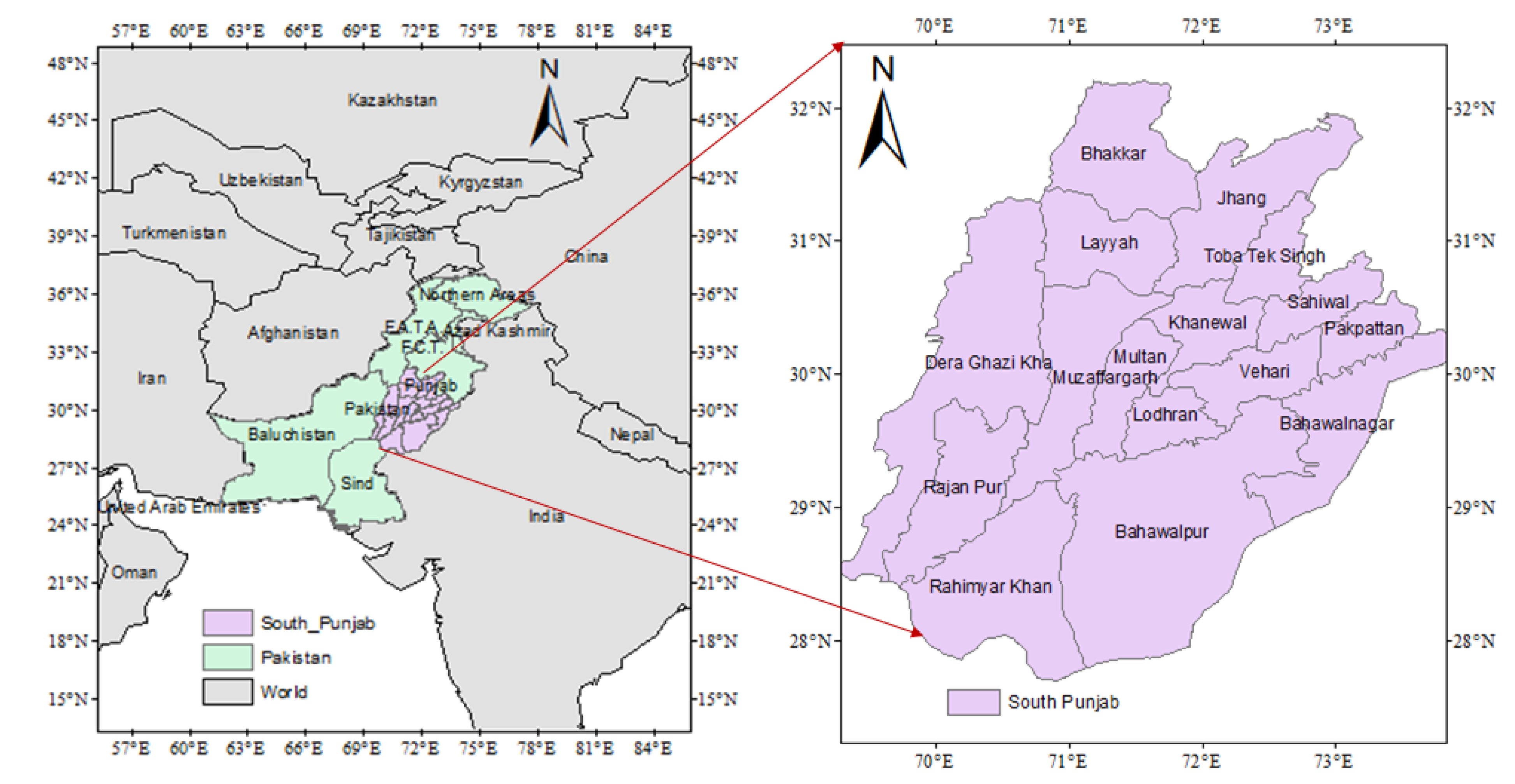

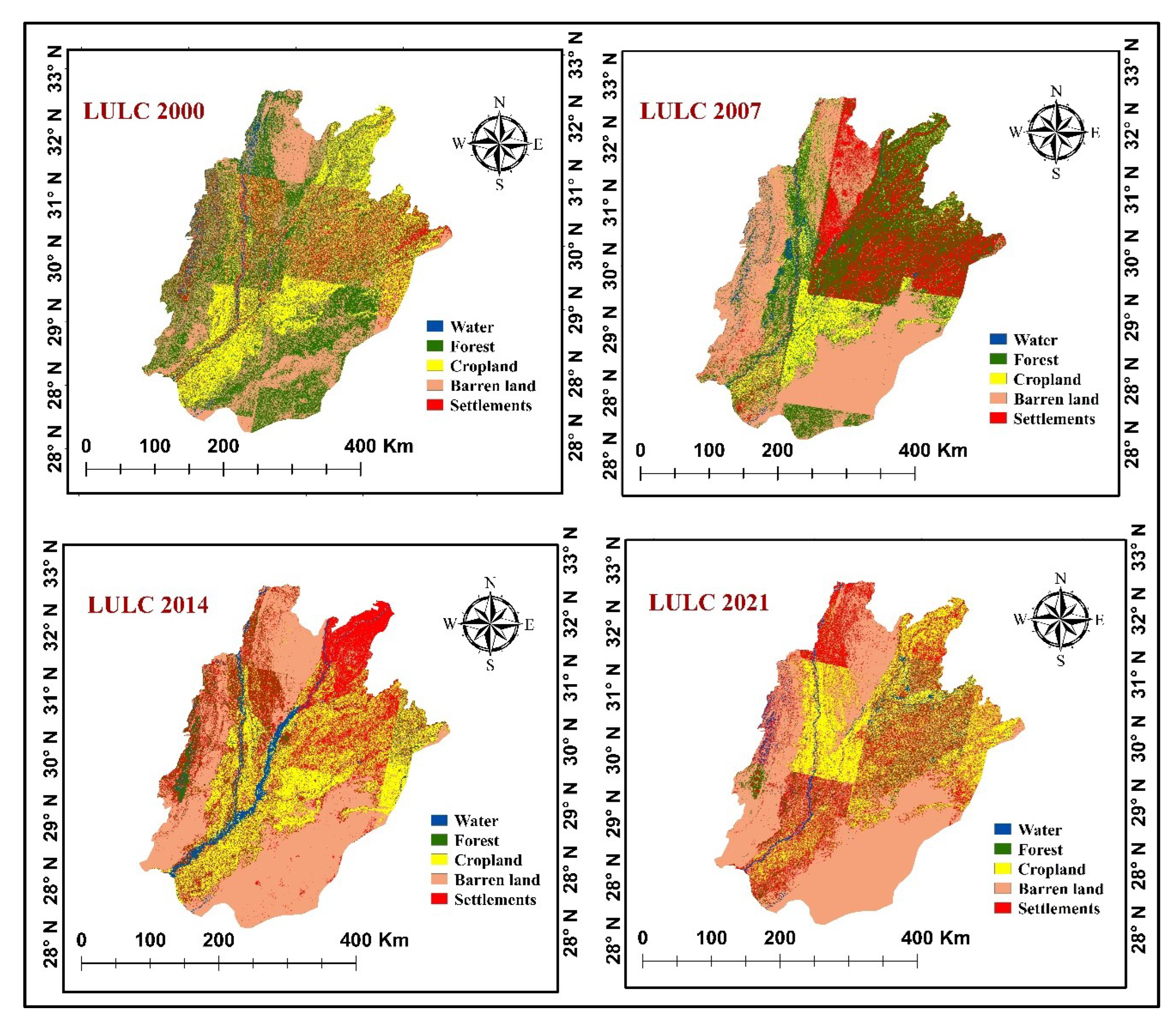
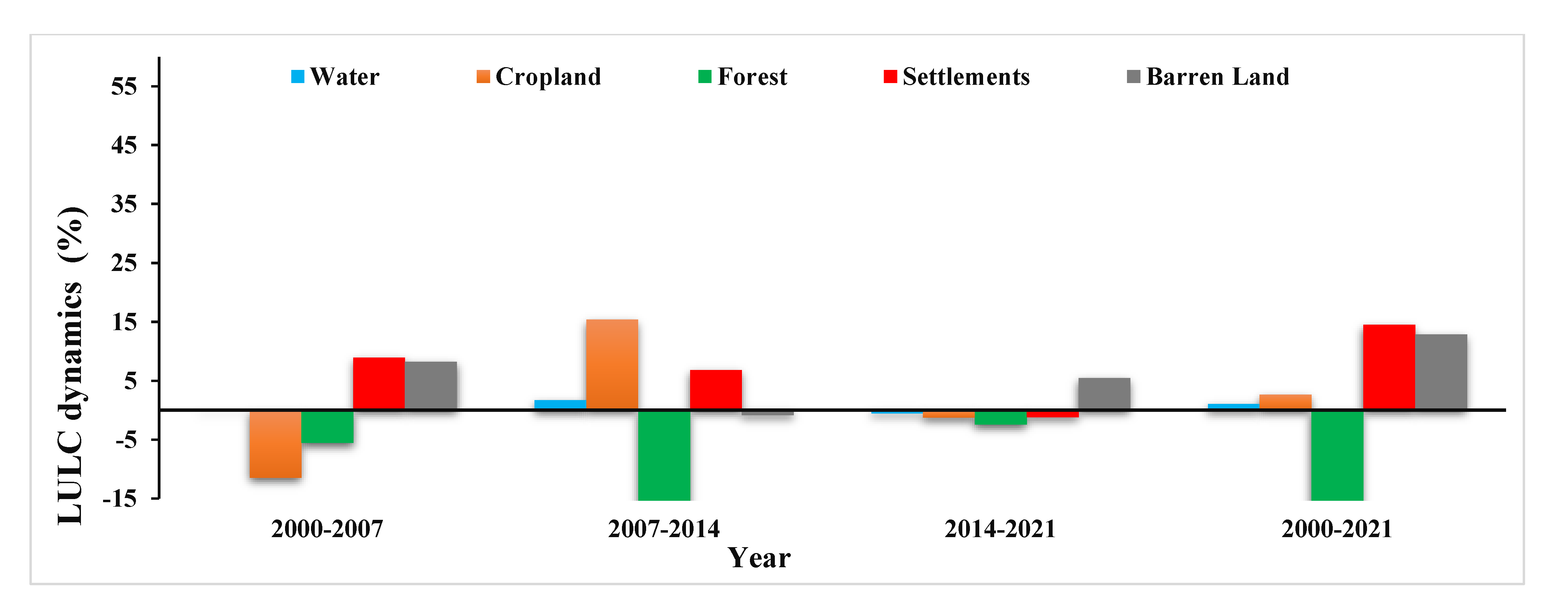
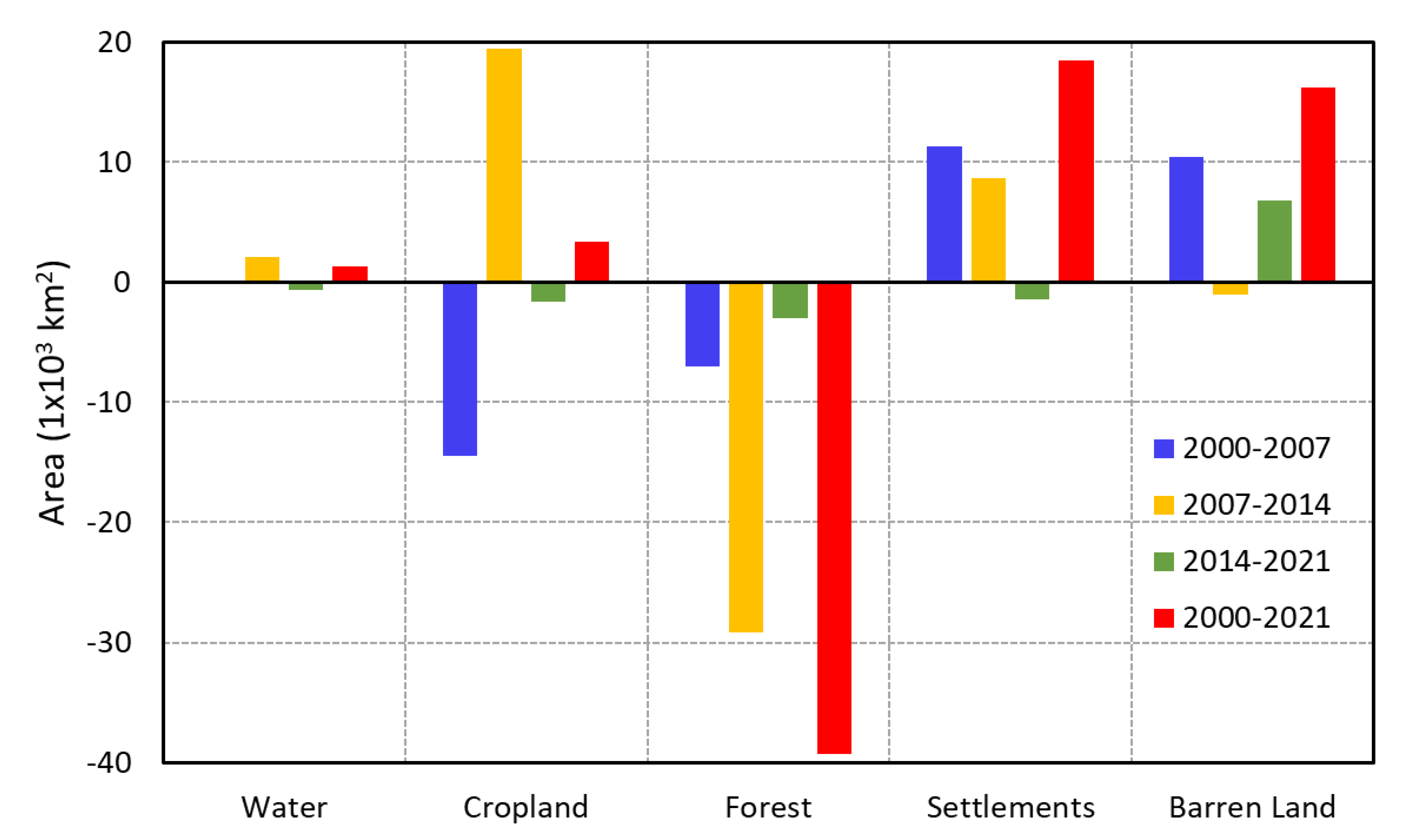
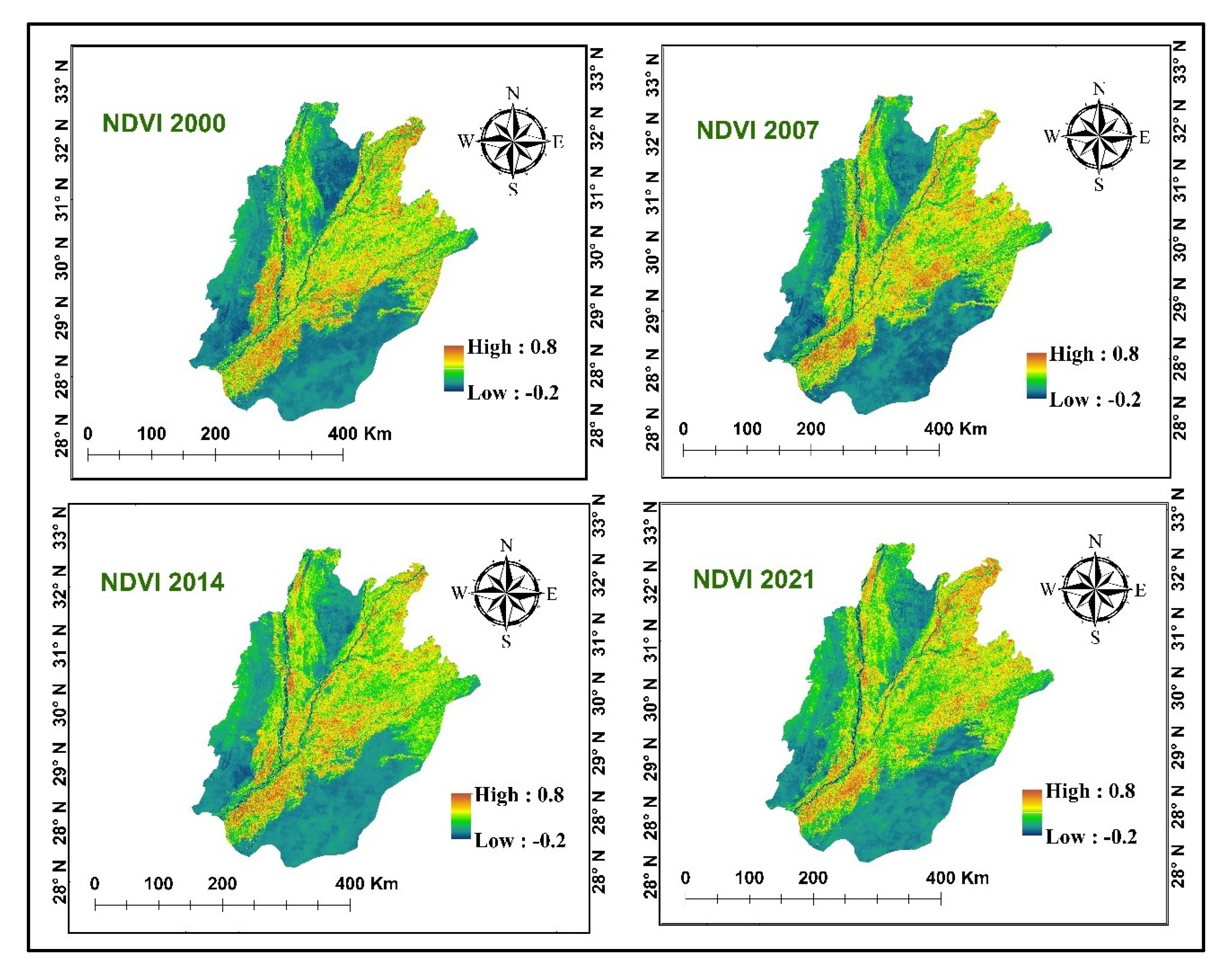
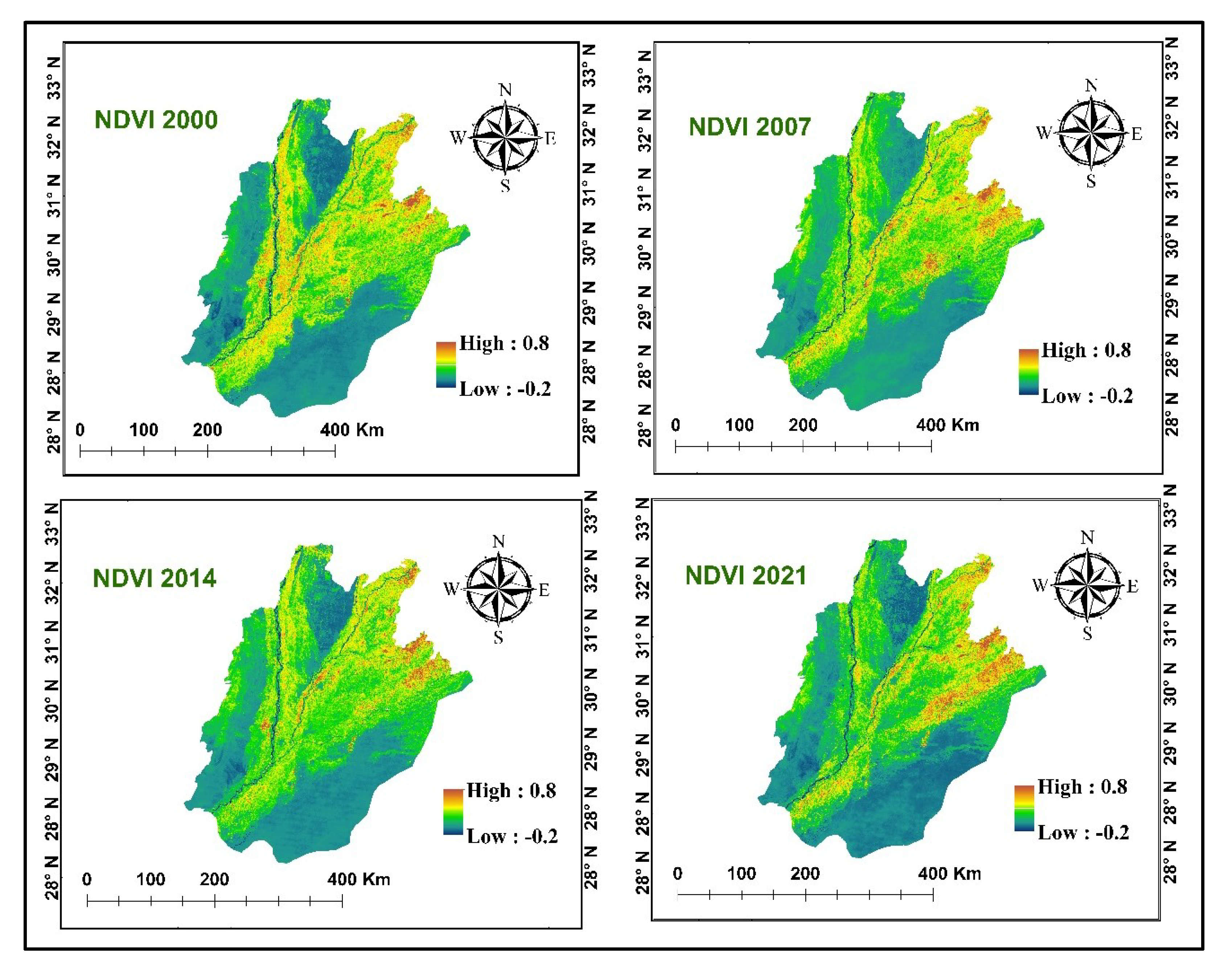
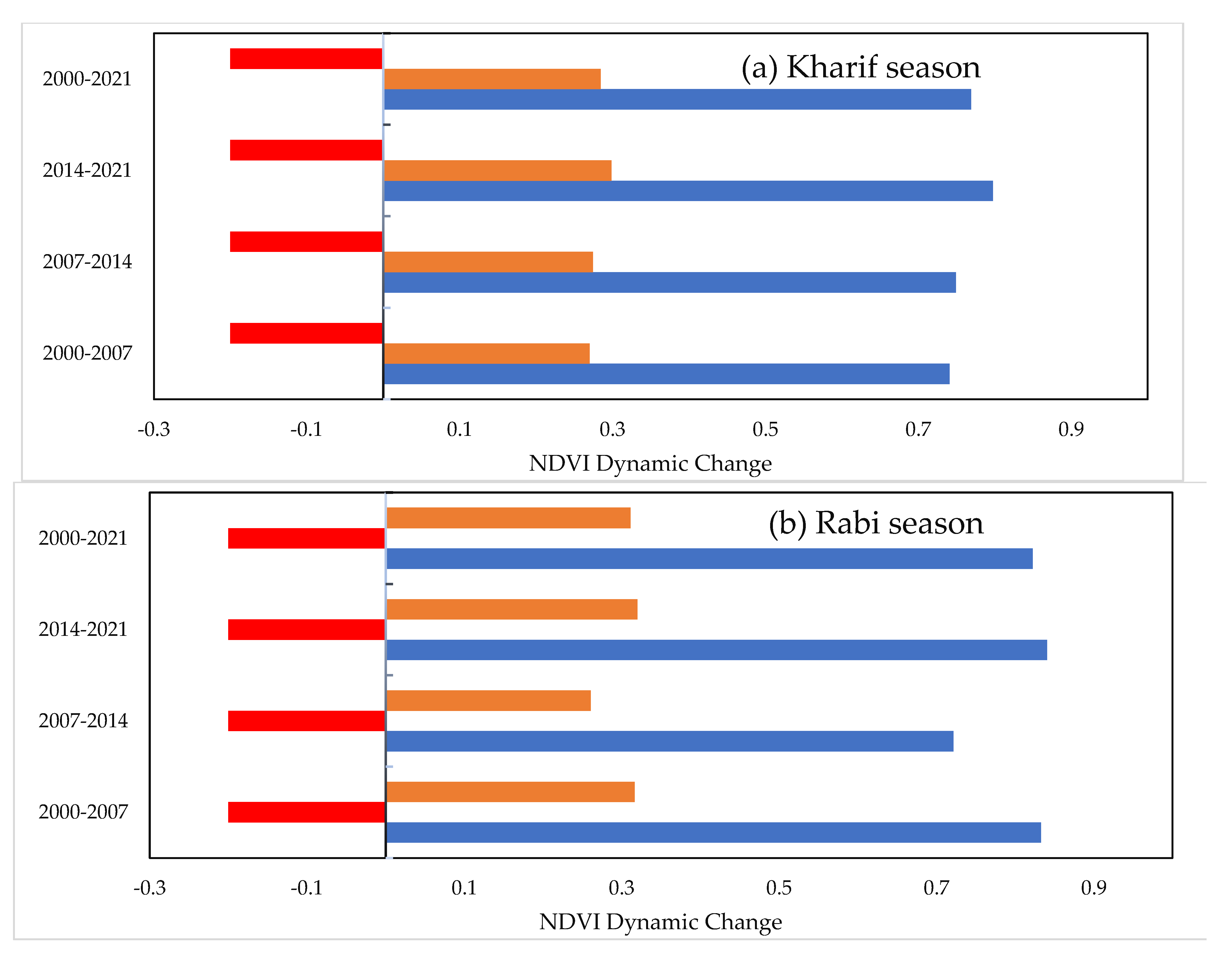
| Access Date | Acquisition | Satellite | Sensor | Band Used | Path/Row | Resolution (m) | Cloud Cover (%) |
|---|---|---|---|---|---|---|---|
| 25/05/2022 | 06/11/2000 | Landsat 5 | TM | 1,2,3,4,5,7 | 149/39, 149/40, 150/38 to 150/41, 151/38 to 151/41 | 30 | 0 |
| 25/05/2022 | 28/11/2007 | Landsat 5 | TM | 1,2,3,4,5,7 | 149/39, 149/40, 150/38 to 150/41, 151/38 to 151/41 | 30 | 0 |
| 28/06/2022 | 25/08/2014 | Landsat 8 | OLI-TIRS | 1,2,3,4,5,6,7,9 | 149/39, 149/40, 150/38 to 150/41, 151/38 to 151/41 | 30 | 0 |
| 28/06/2022 | 15/10/2021 | Landsat 8 | OLI-TIRS | 1,2,3,4,5,6,7,9 | 149/39, 149/40, 150/38 to 150/41, 151/38 to 151/41 | 30 | 0 |
| SDS Name | Description | Units | Data Type | Valid Range | Scale Factor |
|---|---|---|---|---|---|
| 250 m 16 days NDVI | 16 day NDVI | NDVI | 16-bit signed integer | −2000 to 10,000 | 0.0001 |
| 250 m 16 days EVI | 16 day EVI | EVI | 16-bit signed integer | −2000 to 10,000 | 0.0001 |
| 250 m 16 days VI Quality | VI quality indicators | Bit Field | 16-bit unsigned integer | 0 to 65,534 | N/A |
| 250 m 16 days red reflectance | Surface Reflectance Band 1 | N/A | 16-bit signed integer | 0 to 10,000 | 0.0001 |
| 250 m 16 days NIR reflectance | Surface Reflectance Band 2 | N/A | 16-bit signed integer | 0 to 10,000 | 0.0001 |
| 250 m 16 days blue reflectance | Surface Reflectance Band 3 | N/A | 16-bit signed integer | 0 to 10,000 | 0.0001 |
| 250 m 16 days MIR reflectance | Surface Reflectance Band 7 | N/A | 16-bit signed integer | 0 to 10,000 | 0.0001 |
| 250 m 16 days view zenith angle | View zenith angle of VI Pixel | Degree | 16-bit signed integer | 0 to 18,000 | 0.01 |
| 250 m 16 days sun zenith angle | Sun zenith angle of VI pixel | Degree | 16-bit signed integer | 0 to 18,000 | 0.01 |
| 250 m 16 days relative azimuth angle | Relative azimuth angle of VI pixel | Degree | 16-bit signed integer | −18,000 to 18,000 | 0.01 |
| 250 m 16 days composite day of the year | Day of year VI pixel | Julian day | 16-bit signed integer | 1 to 366 | N/A |
| 250 m 16 days pixel reliability | Quality reliability of VI pixel | Rank | 8-bit signed integer | 0 to 3 | N/A |
| Land Use | 2000 | 2007 | 2014 | 2021 | 2000–2021 | ||||
|---|---|---|---|---|---|---|---|---|---|
| Area (Km2) | Area (%) | Area (Km2) | Area (%) | Area (Km2) | Area (%) | Area (Km2) | Area (%) | Change (%) | |
| Water | 2601.05 | 2.06 | 2470.08 | 1.95 | 4592.90 | 3.63 | 3904.15 | 3.08 | 1.02 |
| Cropland | 26,024.41 | 20.58 | 11,518.71 | 9.11 | 30,986 | 24.50 | 29,395 | 23.21 | 2.63 |
| Forest | 44,756.13 | 35.39 | 37,722.03 | 29.83 | 8578.51 | 6.78 | 5523.31 | 4.36 | −31.03 |
| Settlements | 11,132.0181 | 8.80 | 22,391.14 | 17.71 | 31,011 | 24.52 | 29,534 | 23.32 | 14.52 |
| Barren Land | 41,925.37 | 33.15 | 52,337.01 | 41.39 | 51,270 | 40.55 | 58,276 | 46.02 | 12.87 |
| Total Area | 126,438.98 | 100 | 126,438.98 | 100.00 | 126,438.98 | 100 | 126,438.98 | 100 | 0.00 |
| Land Use | 2000–2007 | 2007–2014 | 2014–2021 | 2000–2021 |
|---|---|---|---|---|
| Water | −131.0 | 2122.8 | −688.7 | 1303.1 |
| Cropland | −14,505.7 | 19,467.5 | −1591.0 | 3370.9 |
| Forest | −7034.1 | −29,143.5 | −3055.2 | −39,232.8 |
| Settlements | 11,259.1 | 8620.3 | −1477.9 | 18,401.5 |
| Barren Land | 10,411.6 | −1067.2 | 6813.2 | 16,157.6 |
| Year | User Accuracy (%) | Producer Accuracy (%) | Overall Accuracy | Coefficient K | ||||||||
|---|---|---|---|---|---|---|---|---|---|---|---|---|
| a | b | c | d | e | a | b | c | d | e | (%) | (%) | |
| 2000 | 90 | 100 | 80 | 90 | 80 | 100 | 76.92 | 88.88 | 100 | 80 | 88 | 85 |
| 2007 | 100 | 90 | 70 | 100 | 100 | 100 | 81.81 | 88.88 | 87.5 | 100 | 86 | 82.76 |
| 2014 | 90 | 100 | 80 | 80 | 100 | 100 | 76.92 | 100 | 88.88 | 90.9 | 90 | 87.5 |
| 2021 | 100 | 100 | 75 | 75 | 100 | 100 | 71.43 | 100 | 100 | 100 | 90.63 | 88.24 |
| Years | Kharif Season | Rabi Season | ||||
|---|---|---|---|---|---|---|
| High Value | Low Value | Mean Value | High Value | Low Value | Mean Value | |
| 2000 | 0.7406 | −0.2 | 0.2703 | 0.8328 | −0.2 | 0.3164 |
| 2007 | 0.7491 | −0.2 | 0.2745 | 0.7215 | −0.2 | 0.2607 |
| 2014 | 0.7975 | −0.2 | 0.2987 | 0.8404 | −0.2 | 0.3202 |
| 2021 | 0.769 | −0.2 | 0.2845 | 0.8223 | −0.2 | 0.3111 |
Disclaimer/Publisher’s Note: The statements, opinions and data contained in all publications are solely those of the individual author(s) and contributor(s) and not of MDPI and/or the editor(s). MDPI and/or the editor(s) disclaim responsibility for any injury to people or property resulting from any ideas, methods, instructions or products referred to in the content. |
© 2023 by the authors. Licensee MDPI, Basel, Switzerland. This article is an open access article distributed under the terms and conditions of the Creative Commons Attribution (CC BY) license (https://creativecommons.org/licenses/by/4.0/).
Share and Cite
Hu, Y.; Raza, A.; Syed, N.R.; Acharki, S.; Ray, R.L.; Hussain, S.; Dehghanisanij, H.; Zubair, M.; Elbeltagi, A. Land Use/Land Cover Change Detection and NDVI Estimation in Pakistan’s Southern Punjab Province. Sustainability 2023, 15, 3572. https://doi.org/10.3390/su15043572
Hu Y, Raza A, Syed NR, Acharki S, Ray RL, Hussain S, Dehghanisanij H, Zubair M, Elbeltagi A. Land Use/Land Cover Change Detection and NDVI Estimation in Pakistan’s Southern Punjab Province. Sustainability. 2023; 15(4):3572. https://doi.org/10.3390/su15043572
Chicago/Turabian StyleHu, Yongguang, Ali Raza, Neyha Rubab Syed, Siham Acharki, Ram L. Ray, Sajjad Hussain, Hossein Dehghanisanij, Muhammad Zubair, and Ahmed Elbeltagi. 2023. "Land Use/Land Cover Change Detection and NDVI Estimation in Pakistan’s Southern Punjab Province" Sustainability 15, no. 4: 3572. https://doi.org/10.3390/su15043572
APA StyleHu, Y., Raza, A., Syed, N. R., Acharki, S., Ray, R. L., Hussain, S., Dehghanisanij, H., Zubair, M., & Elbeltagi, A. (2023). Land Use/Land Cover Change Detection and NDVI Estimation in Pakistan’s Southern Punjab Province. Sustainability, 15(4), 3572. https://doi.org/10.3390/su15043572










